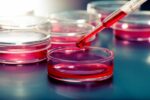Extracellular matrix may be key to behavior of myofibroblasts in PF
Study's findings may help in developing therapies for scarring

The dynamics of the extracellular matrix (ECM) that surrounds cells and gives structure to tissues may play an important role in the behavior of myofibroblasts, the connective tissue cells that are implicated in pulmonary fibrosis (PF), according to a recent study.
“Our results underline the importance of the interactions between cells and the extracellular matrix,” Mario Benn, a research assistant at ETH Zurich and the study’s first author, said in a university press release.
The researchers say their findings can be leveraged to develop therapeutic approaches for diseases, such as PF, that are marked by aberrant connective tissue behavior and scar tissue buildup.
The study, “How the mechanobiology orchestrates the iterative and reciprocal ECM-cell cross-talk that drives microtissue growth,” was published in the journal Science Advances.
Studying the interplay between myofibroblasts and the ECM
The ECM refers to the dynamic network of molecules that surrounds cells and gives structural support to body tissues. It also plays a number of other critical roles, including in cell growth and tissue repair.
Fibroblasts are a type of connective tissue cell that work to assemble the ECM and make sure it remains healthy. Upon injury, fibroblasts transform into myofibroblasts, which are critical for wound healing and tissue regeneration.
“When it comes to wound healing, myofibroblasts are our friends,” Benn said.
After the wound heals, the myofibroblasts revert back into fibroblasts. But a failure in that process, along with overactivation of myofibroblasts, have been implicated in PF, which is marked by excessive scar tissue buildup and inflammation in the lungs.
“If we can understand how myofibroblasts and fibroblasts change into one another, and control that process, then we can also make major progress with conditions such as wound-healing disorders, fibrosis and cancer,” Benn said.
While some work has looked at this, little research has explored how ECM dynamics might play a role in the process — which, according to Viola Vogel, an ETH professor and a study author, is a major oversight.
“Studying cells without the extracellular matrix is a bit like studying the behaviour of spiders without their web,” Vogel said.
To address that gap, the scientists examined human fibroblast/myofibroblast and ECM dynamics in a three-dimensional microtissue culture system. This system offers a more accurate way of studying ECM growth than previous lab techniques, the researchers say.
Studying cells without the extracellular matrix is a bit like studying the behaviour of spiders without their web.
The team found that myofibroblasts are always found in areas where new tissue is being formed and maturing. That’s where these cells work to form a temporary, or immature version of ECM that progressively develops into a more stable type.
A “rapid remodeling” of the ECM appeared to trigger the reversion of myofibroblasts back into fibroblasts, according to the researchers.
More specifically, the team found this conversion was promoted when a type of ECM fiber called fibronectin was stretched into a more relaxed state. These fibers were more tense in areas of growth, where a higher number of myofibroblasts were found.
In matured zones of the ECM, myofibroblasts had converted back into fibroblasts, through a process similar to that seen during wound healing in human tissue, Benn noted.
A number of molecules were identified as key players in this complex process.
When scientists interfered with the composition or structure of the ECM by disrupting these molecules, they were able to mimic conditions like PF, where myofibroblasts don’t convert back to fibroblasts.
Ultimately, “tissue growth is delicately organized in time and space, like a well-orchestrated symphony, where different actors are transiently required, and their individual actions are switched on and off in time,” the scientists wrote.
Researchers believe that their method of studying the ECM in cell cultures using patient cells could offer a way to evaluate potential therapeutic candidates for fibrotic diseases and certain cancers marked by myofibroblast activation.
Benn also sees a future where so-called mechano-medicine is a prevalent practice. Such an approach would employ findings from studies like this one that look at how cells sense and process mechanical signals to develop new therapeutic strategies.
“With many conditions, including pulmonary fibrosis, successful treatment depends on early detection,” said Benn, who believes that by studying the ECM in greater detail, biomarkers for early detection of PF and other fibrotic diseases may also emerge.








